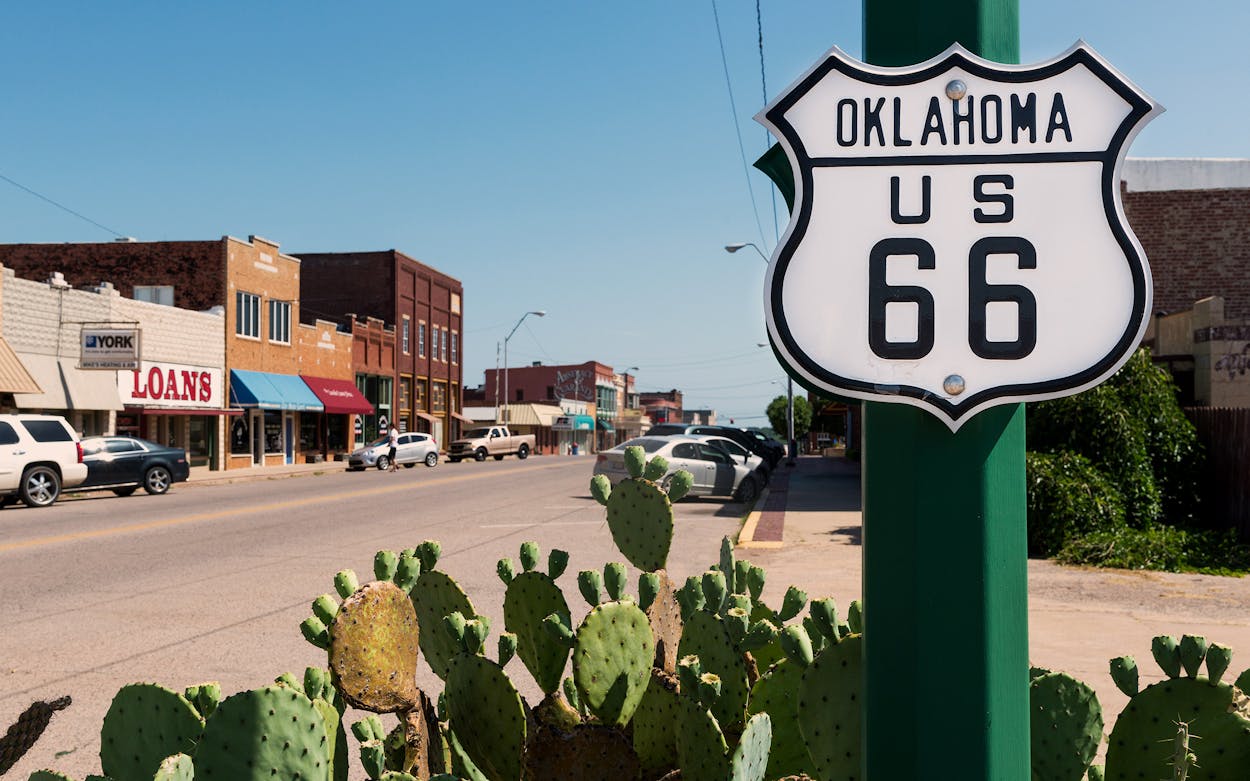The Mother Road, traversing about 2,400 miles from Chicago to Santa Monica, California, was decommissioned as a federal highway in the eighties, but the escapism and opportunity it represented still pull in nostalgia seekers and those inspired by the Route 66 canon that includes The Grapes of Wrath, On The Road, and National Lampoon’s Vacation. What if you don’t have the time or the stamina for an epic journey? What if you’re just connecting dots for a child—or a whole family, if I’m being honest—obsessed with Pixar’s Cars? A long weekend may be sufficient.
With over four hundred drivable miles, Oklahoma offers more Route 66 than any other state. That means more of the classic diners, quirky museums, kitschy roadside attractions, and faded glory. The route’s verdant eastern stretch passes through Tulsa. Continuing east to west, as the Joads and the Griswolds did, the central stretch goes through Oklahoma City, one of only three state capitals on Route 66. Finally, the western stretch opens up to prairie lands and top Route 66 museums. America the beautiful!
Here’s the catch. My road-tripping threshold, beyond which the experience stops being pleasant, is around three hours per day. Ditto for my seven-year-old son, who was nonetheless curious about Route 66. “I Google Earthed it, and I wanted to go there for my whole life,” he claimed.
Husband and I figured if we set up a home base in Oklahoma City, that would minimize time spent driving to and from Route 66, ensure a comfortable stay with myriad dining options every night, and eliminate the hassle of packing and repacking daily. We’d go east and back one day, then west and back the next day.
Departing from Dallas, we shot up Interstate 35 to OKC (our maximum three-hour drive for the day). We checked into the Skirvin Hilton, a grand hotel built in 1911 that met my criteria—historic and effortless. The next day, a Friday, we hopped on eastbound Route 66 and in no time, we were reveling in its gentle hills and curves, pretty little farms, and patinaed structures. In just a few minutes we hit Arcadia, known for the Round Barn, a beloved landmark built in 1898 that is exactly what it sounds like, and Pops, a dazzling gas station, restaurant, and “soda ranch” boasting seven hundred kinds of fizzy drinks.
From there it’s just ten minutes to Luther, then a short drive to Wellston, and so on, each town offering a historical, cultural, or ingestible reason to stop briefly. The Route 66 Interpretive Center in Chandler, which occupies a repurposed armory built by the Works Progress Administration, helped us quickly get a handle on history. We pressed on to Stroud, the easternmost town on the central stretch, on a pilgrimage to the historic Rock Café, whose owner was the inspiration for Sally the Porsche in Cars. We scored a table in the Cars corner and gawked at the movie memorabilia.
Doubling back toward OKC, we stopped to linger in the Seaba Station Motorcycle Museum, a gas station built in 1921 that now houses more than one hundred bikes. In all, we capped a fully satisfying day of vehicular pleasures, with a total drive time around two hours.
Back in the city, we stayed on theme. Packard’s New American Kitchen serves classic dishes in a former Packard dealership from the 1920s and features the original tile floors. In its heyday, Automobile Alley was home to more than fifty car showrooms (Studebaker! Cadillac!). Today, this arty district is emblazoned with neon and many stylish nods to its golden age.
As we ventured west on Saturday, the drive demanded active navigation because Route 66 becomes less contiguous and gets overlaid by other highways and main streets. Most of the attractions in this part of the central stretch are situated off the route, calling for detours that we resisted. I could not, however, resist shopping at Cherokee Trading Post, a massive gift shop in Calumet.
After crossing Geary’s picturesque Pony Bridge, we entered the western stretch, where the route becomes more of a straightaway. We sliced through the wide-open prairies and the farms extending to the horizon, and felt a distinct sense of communion with nearly a century’s worth of fellow travelers. They, too, must have marveled at the spaciousness.
In Hydro we investigated Lucille’s Service Station, a 1920s-era gas station where a woman dubbed “Mother of the Mother Road” raised a family and ran the show for nearly sixty years. Shuttered but well tended, it’s worth peeking inside and contemplating the family members’ lives.
We reached our Western destination, the Oklahoma Route 66 Museum in Clinton, considered the most definitive Route 66 museum in the state, if not the country. We wandered chronologically through exhibits detailing the road’s construction, the Dust Bowl, World War II, and the commercial ecosystems that the route enabled, like diner culture and leisure travel. We caved and bought a Route 66 sign for our den.
Content with our firsthand experience of an American icon, we returned to Oklahoma City . . . via Interstate 40. I know, blasphemy. Saturday’s total drive time: three hours.
This article originally appeared in the May issue of Texas Monthly with the headline “Get Your Kicks.” Subscribe today.







